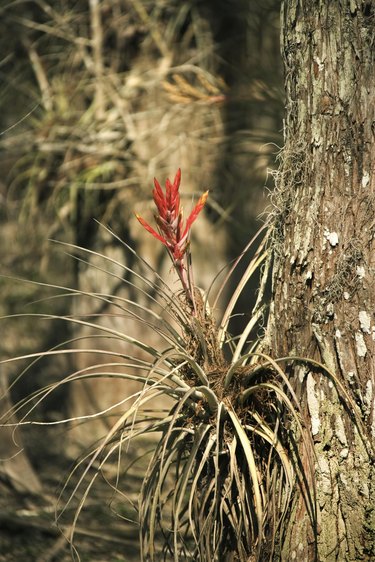
The most famous bromeliad in the genus Tillandsia is Spanish moss, found draping the boughs of trees across the southeastern United States. Tillandsia is the largest group of bromeliads, numbering more than 550 species. All are native to tropical North or South America, and have thin or succulent leaves that are green to gray in color. Tillandsias need bright light, sometimes even direct sun rays, to grow their best. A moist air and drenching, warm rains must drain away fully from their leaves. Any tillandsia, also known as an air plant, will develop brown tissues if growing conditions are awry.
Light
Video of the Day
Ensure your tillandsia is receiving the correct amount of light to remain healthy. Too much hot, drying sunlight can scald and desiccate leaves, while too much shade -- coupled with wet conditions -- leads to leaf rot. Deduce the light needed by the tillandsia based on the leaf. The stiffer, thicker/wider and grayer the leaf, the brighter the light needs to be. Thin, green-leaved plants must not bake in hot midday sunlight. Ideally, any tillandsia may be grow indoors behind a sheer curtain next to a southern window. Very bright, indirect light is best.
Video of the Day
Plant Orientation
Although the rosette of leaves on most tillandsias looks as though they should be oriented perfectly upright, this can lead to brown leaf bases from rot. Tillandsias need water to survive, but the rainwater must saturate the leaves but fully drain away. Orienting a tillandsia upright so its rosette catch and hold water in leaf bases encourages fungal and rot problems. Instead, mount tillandsias at a slight angle. This lets you see the rosette better to enjoy aesthetically, but also helps all water to fully drain off all parts of the plant.
Water and Humidity
Always water tillandsias with room-temperature water, or outside air-temperature water, depending on where you grow them. Misting the leaves daily is not a long-term, successful strategy. This leads to leaf dehydration, especially from spring to fall. Douse tillandsias in a bucket of water for 1 to 5 minutes, and then remove it to fully drip-dry. During the warmth of spring to fall, when sunlight rays are most intense, high ambient humidity -- at or above 50 percent -- prevents leaf drying. However, high humidity, low light and incorrect plant orientation all quickly lead to marked brown rot across tillandsia plants.
Temperatures
While a very few species tolerate frost, err to keep tillandsia plants where they're not exposed to subfreezing or very hot temperatures. A range of 40 to 70 degrees Fahrenheit in winter is fine, but 80 to 100 F in summer is the upper limit. Hotter temperature increase the need for humidity and watering. Colder temperatures are best met with less watering. Frost can lead to leaf dieback and rot, especially if the tillandsias remain too wet when cold.
Other Tips
Do not overfertilize tillandsias. The salts in fertilizers can burn plant leaves. Very dilute, one-eighth to one-quarter strength, but repeated liquid feedings every three to six weeks from spring to fall are warranted. Avoid using copper of any kind around bromeliads, including fertilizer products or containers. Copper is deadly to tillandsias.